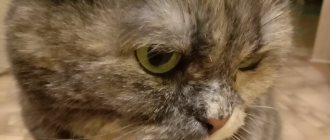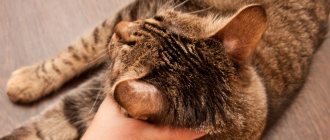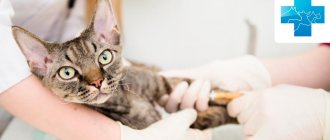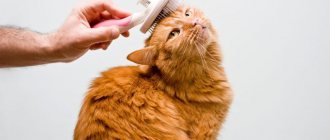What is VIC
Feline immunodeficiency virus (FIV) is an infectious disease that depletes the immune system. Most often, it affects cats over the age of 5 years, who roam freely on the street or live in crowded conditions.
Description of the virus
The international name for feline immunodeficiency is FIV, or Feline Immunodeficiency Virus. It is caused by a lentivirus, which has a long incubation period. This pathogen is part of the retrovirus family and is a close relative of HIV.
The FIV virus was discovered by Americans when they found it in a Californian nursery. Despite its relationship with HIV, the feline infection has its own differences. The pathological effect of the pathogen occurs on T-lymphocytes, which are responsible for the acquired immune response. With timely treatment, a sick pet can live a long and happy life.
Danger to the animal
Due to the depletion of the immune system, secondary infections occur. Having lost its defenses, the body cannot fight back, so the animal often dies due to concomitant diseases.
An equally dangerous consequence is leukemia, that is, blood cancer. This cancer develops against the background of hematological disorders, accompanied by severe anemia (anemia).
Mechanism of action of the virus
The main route for the virus to enter a cat’s body is through damaged skin. Once in the blood, it damages mature immune cells. Infected white blood cells can no longer perform their functions, which leads to a permanent decrease in immunity. The peculiarity of the FIV virus is that it has many different subtypes or serotypes, which makes it impossible to create a strong vaccine against it.
As with HIV infection, which is transmitted by people, there have been no documented cases of recovery in immunocompromised pets.
[custom_ads_shortcode3]
Is FIV transmitted to humans?
HIV in humans and FIV in cats are diseases caused by different pathogens from the same family. Because of this feature, neither an animal nor a person can infect each other. However, owners of sick pets should not let their guard down. With secondary infection, they can become infected from their baleen:
- leptospirosis;
- protozoal infections (toxoplasmosis, giardiasis, cryptosporidiosis);
- ringworm;
- helminthiasis;
- rabies and other dangerous pathologies.
Children under 12 years of age whose immune systems are still developing are at risk. For this reason, it is recommended to limit communication with an infected pet.
Viral immunodeficiency
With or without the occurrence of unfavorable factors, severe symptoms appear. By analogy with the development of the disease in humans, this stage can be called acquired immunodeficiency syndrome. It is characterized by the occurrence of conditions that are dangerous and pose a threat to life:
- sudden weight loss, exhaustion;
- elevated temperature;
- skin rashes of various origins;
- enlarged lymph nodes;
- disruption of the functioning of all organs and systems;
- eye lesions;
- blood diseases;
- neurological manifestations;
- dental diseases.
A cat with FIV may develop symptoms of toxoplasmosis or lymphoma. Resistance to other infectious and fungal diseases decreases, and their course worsens. The treatment does not have the desired effect. Animals get sick for a long time and die from secondary infections.
[custom_ads_shortcode1]
Ways of infection of cats
Transmission of the virus occurs by contact through the patient’s biological fluids: sperm, blood, saliva. An animal can become infected:
- during mating;
- in utero;
- during blood transfusion (blood transfusion);
- from a bite or scratch through saliva;
- during licking by an infected person (provided there are lesions on the skin or mucous membranes).
Cats living outside are more aggressive than domestic cats. To survive, they have to fight for food and shelter, so they are at risk. The number of infections is also influenced by uncontrolled matings, common among stray animals.
Disease prognosis
The prognosis is determined by the strain of the pathogen, the state of the cat's immune system, and whether it receives treatment and proper care. The life expectancy of infected cats is lower than that of uninfected cats; the average difference is 1–2 years. At the same time, the life expectancy of a pet with advanced clinical immunodeficiency rarely exceeds 1–2 years, so the prognosis for life in each specific case can be difficult to determine. In some cats, the virus remains in a latent state throughout its life and has no clinical manifestations.
Main symptoms
Symptoms of immunodeficiency in cats do not appear immediately. In 18% of those infected, the disease is asymptomatic, reminding of its existence only after the development of secondary diseases.
The first alarming symptoms can be detected after the end of the incubation period. These include:
- inflammation of the lymph nodes;
- loss of activity and appetite;
- hyperthermia (temperature rises above 40 °C);
- weight loss;
- diarrhea and severe dehydration.
With subsequent infection with other infections, the symptoms expand. At this point, the patient’s condition attracts the owner’s attention, as the clinical picture becomes more specific.
Prevention measures
Preventive measures include:
- avoiding contact with infected animals, which occurs when a cat free-ranges;
- castration of a pet will reduce aggressive behavior and the likelihood of infection from a bite received in a fight;
- 3-month quarantine when introducing a new cat into an established cat community, with control tests taken at the beginning, as well as at the end;
- mandatory testing for viral immunodeficiency of animals participating in breeding work and removal of infected ones.
Stages of the disease
Symptoms of FIV in cats depend on the stage of the disease. The incubation period takes from 1 to 1.5 months. Upon completion, the pathology develops in 3 stages:
- Acute stage
. The appearance of clinical symptoms of acute viral infection. The number of leukocytes in the blood decreases, which can be noticed using laboratory diagnostics.
- Latent period
. Takes about 3 years. Symptoms that appeared earlier disappear even without treatment, which complicates the timely detection of the disease.
- Immunological deficiency
. When secondary pathologies are added, inflammatory processes develop in the lungs and urinary tract, chronic stomatitis, rhinitis and other diseases of the nasopharynx. Skin pathologies characteristic of parasitosis, fungal and bacterial infections may also be observed.
If immunodeficiency is detected at a late stage, the prognosis is disappointing. For this reason, it is important to be examined at a veterinary clinic if even the most minor abnormalities appear. If a cheerful pet with a good appetite falls into apathy and refuses its favorite treats, do not expect self-healing. The sudden disappearance of alarming symptoms is just the calm before the storm.
Forecast
The prognosis for feline viral immunodeficiency is cautious. In 20% of cases, animals die within 2 years from the moment of diagnosis (4-6 months from the moment of infection), but more than 50% of infected animals remain clinically healthy at this time. At the last stage of the disease (exhaustion, frequent and severe infections), the average life expectancy is about one year.
(c) Veterinary center for the treatment and rehabilitation of animals “Zoostatus”. Varshavskoe highway, 125 building 1. tel.
8 (499) 372-27-37
Visit to the veterinary clinic
The main method of diagnosing FIV is to examine the blood donated for testing. All other checks are individual and depend on the condition of the animal.
Diagnostics and tests
During the initial examination, a sample of biomaterial is taken from a vein from a mustachioed patient. In the laboratory, it is used to carry out the following tests:
- complete blood count (CBC) and blood biochemical test (BAC), demonstrating elevated protein levels and low numbers of neutrophils, red blood cells and lymphocytes;
- serodiagnosis, or enzyme-linked immunosorbent assay (ELISA), which determines the presence of antibodies to the virus;
- polymerase chain reaction (PCR), which detects DNA fragments of an infectious agent.
The disadvantage of serodiagnosis is that during the incubation period, 10% of FIV-infected people may not develop antibodies. It is also possible for antibody levels to drop sharply, preventing their detection. If the ELISA result is negative and there are abnormalities in the CBC and LBC, PCR diagnostics are mandatory.
Possible maintenance therapy
Treatment of immunodeficiency in cats comes down to eliminating associated symptoms and maintaining immunity. A drug that directly combats the pathogen has not yet been developed.
Veterinarians use analogues for humans as antiviral drugs: Zidovudine, Anti-Flu Immunoglobulin and Virbagen Omega. When they are discontinued, the animal experiences a sharp deterioration in its health, so it must be taken for the rest of its life.
Maintenance therapy is based on the use of:
- immunomodulators (Ribotan, LTCI, Anandin), stimulating the immune system;
- antibiotics (Penicillin, Ampiox, Ampicillin) that suppress the effects of pathogenic microorganisms;
- antihistamines (Suprastin, Diphenhydramine) and glucocorticosteroids (Prednisolone, Dexamethasone), which have anti-inflammatory, antiallergic and antitoxic effects;
- drugs that fight hematological disorders (Leucostim, Epocrine).
In case of severe anemia, a blood transfusion is performed to increase the number of lymphocytes and red blood cells. Despite the good result, the effect of this procedure is temporary. There is also a risk of intolerance to foreign blood cells, which can be fatal.
Caring for a sick animal
If your pet is diagnosed with FIV, remember the following rules:
- A sick cat should not be allowed outside (this is to prevent infection of other animals and protect your pet from various infections).
- Such animals need to be neutered.
- Immunocompromised cats should not be vaccinated.
- Every six months you need to undergo examinations (body weight, examination of lymph nodes, eyes, skin, etc.).
- Blood tests (general and biochemical tests) should be performed once a year.
The owner of an infected pet will have to follow some rules for caring for the cat.
In addition, you will have to give your cat the medications prescribed by the veterinarian. If there is a risk of missing any medication, you can ask a relative. It is also worth using the services of a cat hospital. In veterinary clinics where this service is provided, veterinarians are on duty around the clock - they will give the necessary injections and give pills. I have used a similar service: it is inexpensive, and the supervision of professionals is much better than the help of relatives.
In addition, the sick cat is prescribed a diet (for this you need to consult with the treating veterinarian). The food of an infected animal must be carefully balanced and healthy.
Forecasts for the future
The prognosis directly depends on the condition of the animal and the course of the disease. If diagnosed at a late stage, a cat can live for about a year. At this point, the body is severely depleted by chronic diseases and is maximally vulnerable to any infections.
Death from FIV is rare. On average, cats with this diagnosis live 5-8 years. Given the average life expectancy, FIV-infected pets are more likely to die from old age rather than from infection.
To ensure a long and happy life for a mustachioed pet, the owner will have to regularly give it all the necessary medications and protect it from other diseases with the help of:
- Castration and sterilization. After the operation, the animals become calmer and less likely to get into fights with their relatives.
- Isolation from other animals. Due to a weakened immune system, another infection on the street can be fatal. This will also prevent further spread of FIV.
- Timely treatment for fleas, ticks and worms.
- Avoiding stress. During exciting events (moving, birth of a child, renovation), use calming medications with pheromones.
- Annual vaccination. Vaccinations are permissible only in latent cases and only in a “killed” form. A vaccine administered during an acute form can lead to severe complications.
- Therapeutic diet. Veterinarians recommend using dry food. They prevent the formation of tartar, which is the cause of many diseases.
- Annual blood donation. Regularly checking the results will help to identify possible deviations in a timely manner and adjust the treatment plan.
Before contacting a sick pet, be sure to wash your hands and do not forget to put away your outdoor shoes immediately after returning home. Check the condition of your cat's skin, fur, and mouth daily. The cat must be weighed once a week to guard against sudden weight loss.
Treatment method and prognosis
Unfortunately, it is impossible to cure immunodeficiency. A cure for it has not yet been invented. All therapeutic measures are aimed at eliminating symptoms and associated pathologies, strengthening the immune system and prolonging the life of the animal.
Activation of the immune system of a sick cat is achieved through the use of immunomodulators Gamavit, Gamapren, Immunofan. Veterinarians also note the effectiveness of drugs such as Interferon, Roncoleukin, and anti-influenza immunoglobulin.
An important stage of treatment is vitamin therapy. To strengthen the animal’s immunity, ascorbic acid and vitamins A, B, E, and D are prescribed.
Anti-inflammatory drugs and antibiotics are indicated to eliminate inflammatory and infectious diseases. Prednisolone and Dexamethasone are prescribed as corticosteroids.
With good care and proper treatment, cats with immunodeficiency may well live for another seven years. Stray animals, weakened individuals - no more than three.
With a terminal course of the disease, the prognosis is cautious. As a rule, the life expectancy of sick cats in such cases does not exceed two years.
Structure
Genome structure of the feline AIDS virus based on available data 2013.
FIV has a similar structure to primate and ungulate lentiviruses. The virion has a diameter of 80 to 100 nanometers and is pleomorphic. The viral envelope also has surface projections that are small, 8 nm, and uniformly cover the surface.
The genome of the feline AIDS virus is diploid. It consists of two identical single-stranded RNAs, in each case about 9400 nucleotides, existing in a plus-strand orientation. It has the typical genomic structure of retroviruses, including gag, pol and env genes. The Gag polyprotein is cleaved into matrix (MA), capsid (CA) and nucleocapsid (NC) proteins. Cleavage between CA and NC releases a nine amino acid peptide, whereas cleavage at the C terminus of NC releases a 2 kDa fragment (p2). The Pol polyprotein is translated by ribosomal frameshifting, a feature of HIV. Cleavage of Pol by the viral protease results in the release of the protease itself (PR), reverse transcriptase (RT), deoxyuridine triphosphatase (dUTPase or DU), and integrase (IN). The Env polyprotein is composed of leader (L), surface (SU) and transmembrane (TM) glycoproteins. Like other lentiviruses, the FIV genome encodes additional short open reading frames (ORFs) encoding the Vif and Rev proteins. An additional short ORF called orfA (also known as orf2) precedes the env gene. The function of OrfA in viral replication is unclear, but the orfA-encoded product may display many of the attributes of HIV-1 accessory gene products such as Vpr, Vpu, or Nef.
The capsid protein, derived from the Gag polyprotein, assembles into the viral core (the protein shell of the virus), and the matrix protein, also derived from Gag, forms an envelope directly within the lipid bilayer. The Env polyprotein encodes a surface glycoprotein (SU) and a transmembrane glycoprotein (TM). Both SU and TM glycoproteins are highly glycosylated, which scientists believe may mask B cell epitopes of the Env glycoprotein, conferring virus resistance to virus-neutralizing antibodies.
Other meanings
| « | The word “cat,” as scientists suggest, is borrowed from the Latin language, where cattus, catta are the names of domestic (not wild!) cats and cats. It is believed that the English cat, the German Katze, and the French chat are derived from this Latin word. This happened no later than the 4th century AD. e. - it was then that this word was recorded in Latin, and it was probably then that domestic cats appeared in Rome. The Old Russian word “cat”, derived from the word “cat”, obviously at first looked like *kotjьka. | » |
| — verbiage | ||
| « | xxx: Hello, what are you doing? uuu: Playing with my pussy... uuu: I mean with a cat!!! uuu: I know what you were thinking, asshole!!!! The user "uuu" removed you from his friends list! | » |
| — 412623 | ||
More pussies
| ◄ ► | The Dutchman made the corpse of his cat fly)»»> |
Kote. Spherical in a vacuum Kitten, hedgehog and mimimi Standing Cat is watching You! (spoiler:
The Dutchman made the corpse of his cat fly
) The key of awesome
reveals the topic of cat on the Internet Physical cat culture Cat music Fighting cat on a walk Antidepressant Even Karlin loved cat And Dugin calls for learning from cats
- On our Internet, devices (usually routers) from Cisco are also called cats or pussies.
- Cat/Campons - a piece of climbing equipment or a device for climbing poles.
- A cat is a small anchor for boats.
- A cat is a small board with a hole and hooks for putting it on an easel, if the painting reflects in the artist’s eyes, to change the angle of incidence of the rays.
- Pussy is a slang Americanized designation for the female genital pussy (lit. - pussy
), known in Russian thanks to illiterate translators and used by them as a stupid, dull euphemism. In one old American musical, girls offered to look at their pussies, after which they let kittens out of their skirt pockets. They say that this is where the word pussy came from in the sense of “jasper gate”, but it is not known exactly where the cause is and where the effect is. And in Slovakia this is also the president. - Glamorous pussy.
- The cat is a creature unknown to science (perhaps a substance?), used to pass through the shredder. Not to be confused with Schrödinger's cat!
- Kisa is an erroneous name for the bust of Semyon Mikhailovich Budyonny. If you tell the buyer of a kitty that he made a mistake and is not buying a kitty, but a bust of Semyon Mikhailovich, the buyer will go nuts and ask for two.
- Kisa - Vorobyaninov, accomplice of the great schemer.
- "Kisa" is an acetone triperoxide, an explosive initiator, widely known for its exceptional ease of preparation. In fact, very unstable and capable of snatching a finger or two off the pyrotechnics.
- "Kisa" ( kissa
) in racial Finnish SUDDENLY cat. - But “pussy” in Erzya means suddenly a dog!
- Kote is a cat on the verb.
- Kit is a cat in racial language.
Good to know
- Plague in cats (diagnosis). How to avoid infecting your pet with feline distemper?
- Feline panleukopenia (etiology, therapy). What to do after panleukopenia?
- Viral Leukemia in Cats (Diagnostics, Treatment, Vaccine, Tests for Leukemia in Cats)
- Leptospirosis in cats (etiology, pathogenesis, symptoms, diagnosis, treatment and prevention). Vaccination for leptospirosis
- Viral leukemia in cats (symptoms and treatment)
- Hemobartonellosis in cats and dogs (pathogenesis, diagnosis and treatment). Biological properties of Mycoplasma Haemofelis. Control and prevention measures for hemobartonellosis in cats
- Borreliosis in animals and humans (etiology, therapy, signs and symptoms, prevention). Lyme disease in dogs
- FLV in cats (epizootology, diagnosis and treatment) FeLV for cats (vaccination, prevention and therapy)
- Viral leukemia of cats (therapy, prevention). What to do if my cat is sick with the leukemia virus











